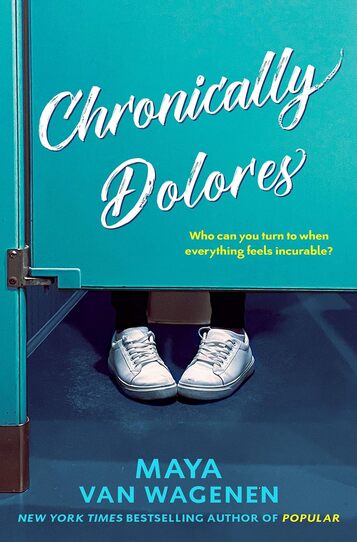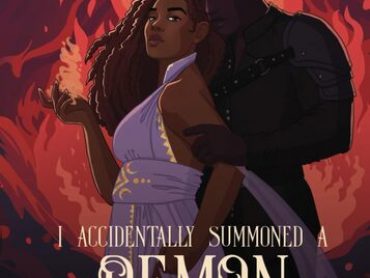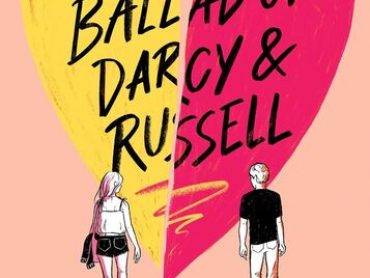Maya Van Wagenen is the author of Chronically Dolores. Chronically Dolores follows Dolores Mendoza who was recently diagnosed with a chronic bladder condition called interstitial cystitis. The novel explores humor, heartache, and a chronic condition. YE was able to speak with Maya about the dynamics of Dolores and Terpsichore’s friendship, creating characters, and her favorite scene or quote from her book.
Young Entertainment: When did the inspiration for Chronically Dolores come about?
Maya Van Wagenen: I started the first draft of what would later become Chronically Dolores during the early days of the pandemic. I had just moved back in with my family and needed something to focus on while everything else felt chaotic. Dolores became my lifeline. While the plot changed a great deal over the ensuing drafts, the characters have largely stayed the same.
YE: Being autistic, and dealing with interstitial cystitis, did you always know that you wanted to incorporate that into a book one day?
MVW: I’ve known for years that I wanted to write a book about a character dealing with interstitial cystitis, but I’d planned on it being adult fiction due to some of the more complex social implications that arose for me later on. However, after seeing the serious gap in representation for teenagers with chronic illnesses, I became passionate about Dolores’s story being one of adolescent diagnoses. Terpsichore’s character developed more organically, less of a conscious decision. At the time, I was coming to terms with my own autism, untangling stereotypes, stigmas, and internalized ableism. This process occurred side-by-side with writing the book.
YE: How would Dolores and Terpsichore describe each other?
MVW: Terpsichore has a knack for reading Dolores better than anyone else in Dolores’s life, including Dolores. Terpsichore sees that Dolores is unhappy and overwhelmed, but she also sees that Dolores has the capacity to build really meaningful relationships, even if she doesn’t always pick the right people. At the beginning of the book, Dolores feels uncomfortable and embarrassed around Terpsichore, called out by Terpsichore’s effortless honesty. Over the course of the book, however, Terpsichore’s integrity impresses Dolores and inspires her to be more authentic.
YE: What was the writing process like?
MVW: While working on Chronically Dolores, I stumbled on a writing process that works really well for me. Ninety percent of the time, I moved scene by scene chronologically. I wrote all the dialogue in the scene first, then when I was happy with how the conversations flowed, I’d fill in everything else. After that, I used a text-to-speech software called Natural Readers and picked a voice that sounded like how I imagined Dolores. I listened to what the complete scene sounded like when read aloud and caught a lot of typos and clarity issues that way. I had a few chapter-by-chapter readers who gave feedback as I went, and then I sent it along to my editor.
YE: What is your favorite part about writing for a young adult audience?
MVW: Everything feels so big when you’re a teenager. You forget that as an adult. Teenagers have such little autonomy yet face intense familial, cultural, and societal expectations. All of this while they’re figuring out their identity and the way they relate to other people and themselves. During this developmental time, they experience so many defining firsts: first love, first heartbreak, first real regret. This is such an emotionally complex landscape to explore in writing.
YE: Do you have an author that has most inspired you?
MVW: Ray Bradbury has been one of my favorite authors since I was young. I devoured his short stories, and Zen in the Art of Writing has been a resource I go back to over and over at various points in my life. I admire Bradbury’s originality, his approach to his work, and his incredible ability to create successful, bestselling books that have the staying power of literary classics. That’s the dream, right?
YE: How would you describe the dynamics of Dolores and Terpsichore’s friendship?
MVW: Dolores’s experience of forming a really intense relationship with her childhood best friend Shae and then getting burned is a pretty common story for queer girls before they figure out their identity. It was certainly the case for me. But Terpsichore isn’t scared away by Dolores’s intensity because she’s intense in her own way. There’s a lot of curiosity between the two girls, and that only strengthens the pull they feel toward one another. They’re intrigued, drawn in. But they’re also inexperienced. They’re navigating new waters. What does healthy communication look like? How do you apologize when you hurt someone? How do you provide real, helpful support to someone you care about? They have to figure all that out together.
YE: What do you hope your readers can take away from Chronically Dolores?
MVW: I want Dolores to help normalize and destigmatize chronic illness for kids and teens. Society doesn’t know what to do with us: the young people who aren’t going to die but aren’t going to get better. There’s no Hallmark card for that. We’re expected to figure out how to financially support ourselves and our expensive medical care and not burden friends and family with the unglamorous details of our conditions. For kids who are in that position, I want them to read the book and know that they’re not alone. For everyone else, I want them to be able to experience a little bit of what living with a chronic illness is like so they can take that empathy and perspective into the world.
YE: Were any events that took place in Chronically Dolores inspired by your life?
MVW: Absolutely! So much of myself ends up in my fiction. I could list a hundred things that take inspiration from my life, but I’ll pick three of my favorite ones to talk about here. First—-I based Dolores’s urology appointment for the appointment where I received my interstitial cystitis diagnosis. While I exaggerated some of the visual elements, the actual dialogue is pretty much word-for-word the way I remember it. Second—toward the end of the book, Dolores’s Tía Vera brings her a glass vial of dirt from Chimayo, a pilgrimage site revered for its healing powers. My dad and I stopped there on a road trip through the southwest when I was in elementary school. It was a really memorable experience for me and inspired a lot of the faith-healing ideas explored in the book. Third—-in my first apartment, I shared a staircase with the neighbors across the hall. Every footfall reverberated through the walls. I learned a lot about my neighbors by the way they climbed the stairs. Those observations inspired the staircase outside the Mendoza apartment, which becomes a character in and of itself.
YE: What was the best part of creating the characters in your book?
MVW: I love this cast so much. Mostly, they came to me with their personalities and voices fully formed. But their backstories, passions, quirks, and relationships with each other took conscious decision and development. It was fun filling in the blanks. My absolute favorite thing is getting to know characters through dialogue. I feel like that’s where they have the chance to really surprise me. One of them will say something revealing, and I’ll be like, “Huh. Well, I guess I’ll have to figure out what that means.” My characters having secrets they keep from me makes them so much more alive.
YE: What is your favorite scene or quote from Chronically Dolores?
MVW: My favorite scene is the dinner at Tía Vera’s house in chapter five, and my second favorite scene is the pancake breakfast in chapter ten. Both of these involve a big group gathered around a kitchen table. There’s an undercurrent of familial tension, sensory details, lots of gestures and facial expressions, and many of my favorite jokes in the book.
YE: What is a genre you would like to write next? I’m working on an adult fiction manuscript right now. With Chronically MVW: Dolores, it was a bummer to have to censor things from how I pictured them in my head because of the book’s audience. I totally understand why this was the right decision for a novel that rides the line between YA and middle grade. Keeping the language and content age-appropriate ensures it has the widest possible readership. But it was still a bummer. It’s been fun not to worry about that and tackle some more mature topics.




